Off We Go to Eat Berlin
A decently well-researched starter food guide to Germany's capital.
This is a research-built list of food recommendations for Berlin, Germany (not Berlin, Wisconsin). Some of the following recommendations have been validated by friends’ firsthand experience (indicated by a 👍), many still have not.
The research involves many hobby hours delving through other food lists from major publications, food blogs from locals, and review sites, in addition to my favorite inexcusable pastime, “just clicking around on Google Maps.” I browse the menu and website of each restaurant (if they exist) and look at dozens of pictures of the ambience, setting, and food. I read whatever reviews I can find written by someone with half-a-brain (easily the most difficult part of the process). If what I see and read unifies into a “good feeling,” (i.e. the kind of place that I personally would try if I was there myself), then a restaurant makes the list.
This is the process. It is flawed. But it’s also worked out for the folks who take these recommendations more often than not. Do with it as you will!
Recommendations in each section (Breakfast, Lunch, etc.) are generally ordered from most-recommended to least. That said, all are recommended. Recommendations with a (👍) have been validated firsthand by a friend on the scene.
“Off We Go to Eat Berlin” was originally composed as a personalized recommendations list for friends traveling to Berlin. As such, it is slightly biased to them and what I think they would enjoy. If a personalized food guide for your upcoming travel sounds like something you’d like, click here.
Berlin is sprawling-big, diverse, complex, and probably a bit difficult to visit a first time; there’s so much to do, see, drink, and eat.
Personally, I’ve only been to Berlin once, under extremely specific circumstances: it was the last leg of a Spring Break performance trip with my high school choir. I remember enjoying the city, as I enjoyed that entire trip, though my memories of this particular place are slightly overshadowed by the fact that our tour bus got hit by a train. Maybe more of a tram. Train or tram, the long-vehicle-on-rails collided with our long-vehicle-on-wheels, not catastrophically hard, but not exactly a bumper boop. So that’s most of Berlin for me, unfortunately, along with some snippets of memories of being extremely bored in the Pergamon, eating lackluster McDonald’s, and performing in a kind of weird boxy church.
Nonetheless, I like Berlin, or at least the idea of it. There are good times to be had here for folks of all types and interests, if you look in the right corners. I’m excited to visit again, one day, and lay flowers on the road where bus met train (there were no casualties).
Context
A little perspective on visiting Berlin.
Party City — Perhaps even more-so than Ibiza or Mykonos, Berlin is the party capital of Europe. Which, from an American perspective, may be surprising. It’s Berlin! It’s, uh, a big, grey, German city with quite the history. What about that says “party time?”
Yet Berlin’s night life is renowned for its diversity and accessibility, in that there’s essentially a club, a bar, or a stage for any experience, niche or casual, that you could possibly be seeking for your late night or weekend-long escapades. So, not that you’re going to be out and about into the dark hours, but if you are, there are a hundred Berlin scenes waiting for you just around the corner.
Molten Pot — Germany as a whole, and Berlin especially as one of its major cities, is home to many diaspora of peoples both displaced and immigrated; many of them from the Middle East. Don’t be surprised to see Turkish, Syrian, Georgian, Palestinian, and other trans-national neighborhoods (including cafes, clubs, and eateries) throughout the city. The country’s historical welcome of these people — going back to Turkish migrants that helped the country rebuild after WWII — has been a flashpoint of political contention over the last five or so years, though Germany has more or less maintained its spot at the top of the “most welcoming” list of European countries (unfortunately, a list that is not terrifically impressive in 2023). The resulting swirl of distinct heritages shared is a major part of what makes Berlin, Berlin.
English Accepted! But — attempt German! Like in many European countries in this neo-world year 2023, English is frequently spoken in Berlin, to greater and lesser degrees. However, it’s most polite to at least attempt a few words in the host country’s language in a restaurant or other establishment, even if only to say, “I’m sorry, but is English ok?” (Bitte (or Entschuldigung), ist Englisch in Ordnung?) This is an easy way to be not that American tourist. Follow that up by taking your conversation partner’s English fluency into account, and speaking as clearly, simply, and to-the-pointly as you can (it’s amazing how much that helps).
Must-Tries of German Cuisine
Aka “don’t-misses,” “have-to-gets,” or “did-you-really-go-to-Berlin-if-you-didn’t-eats.”
White Asparagus — Germany goes bananas for white asparagus when it’s asparagus season. That may sound weird to us (America), but white asparagus is a popular delicacy throughout Europe. A far cry from the thin, wimpy, bullied typical American asparagus, these larger, tenderer plants are often prepared simply in brown butter and served as a dish of their own. It’s said that there are few vegetables quite as delicious as white asparagus when it’s their time of year; so don’t miss them, especially at a market like Rogacki or great German-cuisine restaurants.
Eisbein — Eisbein is a perfect example of a working-class delicacy: a tough-as-nails cut of dried pork shank or knuckle boiled for near-eternity until it becomes one of the most tender plates of meat on the German table. It is often served with vegetables and/or mashed potatoes (shocking!). It’s worth getting at least once, particularly at a fine traditional German pub or restaurant.
Schnitzel — One of the rare German dishes that I think most Americans have at least heard of. Schnitzel is basically just a pounded-tender-thin slab of fried meat (usually pork, veal, or chicken) served with spaetzle (see below) or potatoes. One of the essential German beer foods, which you should 100% have while drinking beer.
Sausage/Wurst — See “wurst,” think “sausage.” Germany has arguably perfected the sausage, and while it may be hard for the American mind to think of one as a “meal” unto itself, trust me, these are a Hugh Jackman-in-Real Meal. Eh? Don’t hesitate to order one, all the more if it’s a house specialty.
Döner — Döner, or doner kebab, is shawarma, and shawarma is doner. Kind of. Essentially, döner is a Turkish meat shaved off a big, slow-spinning, vertical rotisserie spit, usually layered onto warm flatbread with vegetables, pickles, and a white yogurt and/or sesame and/or spicy sauce. It’s a beautiful thing, more prevalent, more fresh, and more trustworthy than a New York falafel cart. You should have at least one while you’re here (and frankly if you’re having a truly great time in Berlin, you will be having many more than that).
Currywurst — Sausage, chopped and topped with house ketchup and curry powder. Fries, salted and dolloped with mayo. Street food hardly gets more straightforward and rarely better than this. Lives in the same bucket of “good time foods” as döner.
Spätzle — When I was in Germany, spätzle was sold to me as “German mac n cheese.” This is a bad way to sell spätzle, inevitably leading to disappointment. It’s often more like…butter noodles with a “hint of cheese,” usually served as a non-potato, still-starch-forward side to a hearty meat rather than a standalone dish. Expect that, and enjoy your spätzle.
Beer — I shouldn’t have to say this, but drink the beer in Germany. Even if you’re not a beer person. Try it, try lots of it, let it fill you up and bloat you out. That’s the German experience, baby — and it will add directly to the enjoyment of so many of Germany’s favorite dishes. It actually makes many of them make sense. Heck, it makes all of Germany make sense…after one or eight pints.
Breakfast

Annelies (Görlitzer Str. 68, 10997 Berlin, Germany). This might be some of the best-looking brunch food I’ve ever seen on Google. Which is not saying extraordinarily much, because most brunch food is basically the same everywhere, from the look to the taste to the price (several reasons why it is my least favorite meal) and because most Google photos are, pardon my French, trash; but the items at Annelies look fantastic even in Oscar the Grouch’s living quarters-quality Google review pics. The thick, fluffy blueberry pancakes and well-proportioned breakfast sandwich are particular standouts. It looks good enough that I’d recommend making the trip to Kreuzberg just to visit if you have a morning to spare. There’s plenty to do in this area after eating, too; Kreuzberg is one of the trendier neighborhoods in the city (something akin to a Highland Park or Bushwick), with stores, parks, and cafes all a short walk away.
House of Small Wonder (Auguststraße 11-13, 10117 Berlin, Germany). A bright, busy, creative brunch spot just north of Monbijoupark in central Berlin . The menu is mostly Japanese with American and German influences, and all comfort food. Looks terrific — and probably requires a reservation on the weekends.
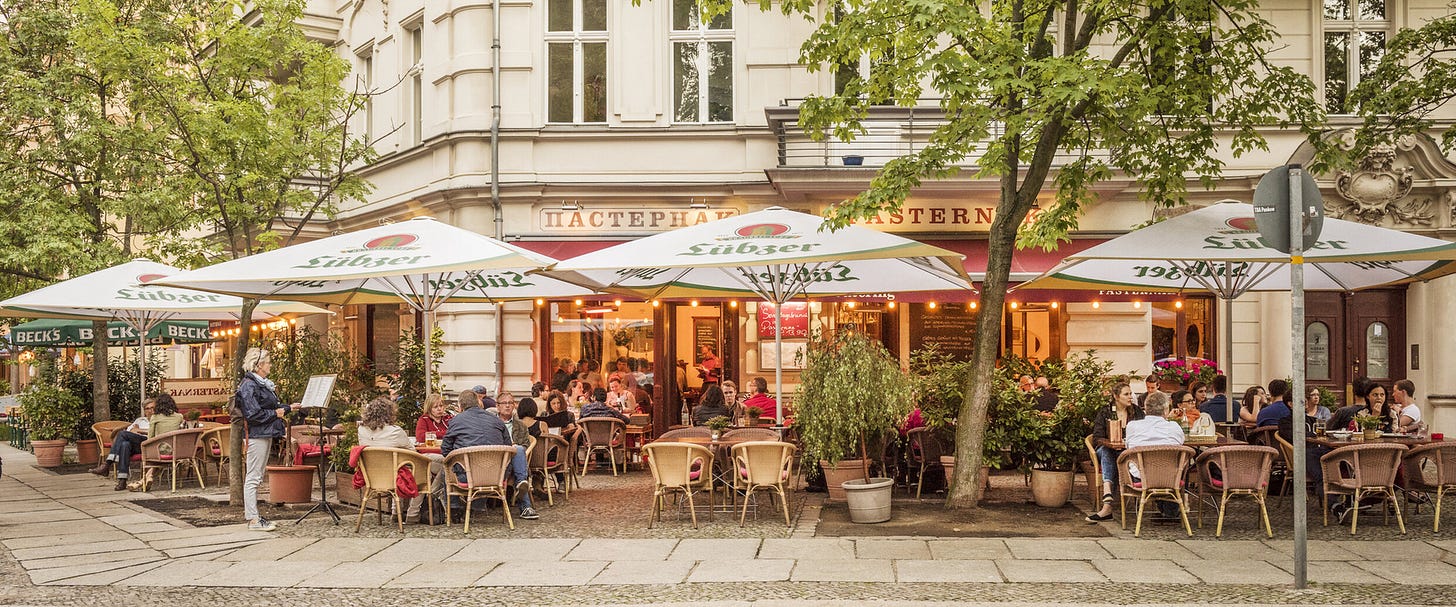
Pasternak (Knaackstraße 22-24, 10405 Berlin, Germany). You don’t have to have breakfast at Pasternak — though it may be the easiest time to get in. Lunch or dinner are just as appropriate at this all-day old school Russo-Jewish cafe. Get coffee and perfect blintzes (or shakshuka or french toast), enjoy at your table in the pub-like interior or streetside on this neighborhood park corner, and appreciate that you’re in a place (Berlin) where a place like this (Pasternak) exists.
FREA Bakery (Gartenstraße 9, 10115 Berlin, Germany). Super cute vegan bakery that seems like a nice place to grab a quick pastry and coffee, an airy lunch, or sit by the window and watch Berlin pass by.
Fine Bagels (Warschauer Str. 74, 10243 Berlin, Germany). Fine Bagels is said to be Berlin’s only good bagel shop. Happily, it’s also said to be great, not just good. Head over to this spot in the Friedrichshain neighborhood for bagels and other sweet Jewish baked treats, as well as a relaxing browse through the Shakespeare & Sons bookstore…inside of which the bagel shop is located? A strange partnership maybe, but one that I love. In fact, a book-and-bagel-store might be one of my personal happiest places on earth.
Lunch
KaDeWe (Tauentzienstraße 21-24, 10789 Berlin, Germany). Short for “Kaufhaus des Westens,” KaDeWe is Germany’s answer to London’s Harrod’s, Singapore’s Jewel Changi, and the US’s…Mall of America, I guess (it is 10,000% nicer than the Mall of America). This massive department store is housed in a stunningly beautiful building inside and out, perfect for spending a few afternoon hours in a climate controlled environment, eating and shopping and people-watching. The food court is set in a gorgeous atrium, and contains decent-to-great versions of all the German and international snack, street, and deli foods that you could ever want.
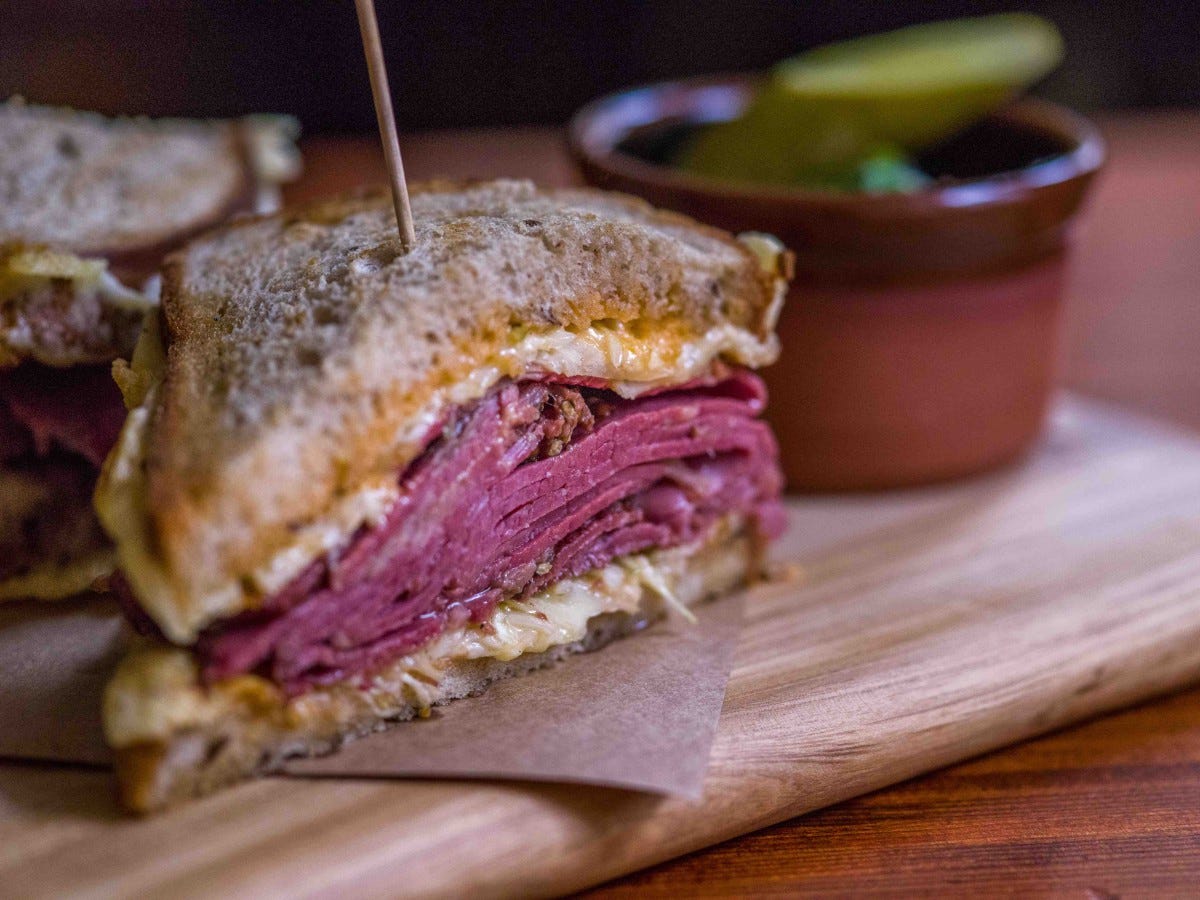
Mogg (Auguststraße 11-13, 10117 Berlin, Germany). A New York-style Jewish deli in the middle of Berlin, housed in a former Jewish girls’ school. Mogg serves a hearty lunch in its rustic, historic atmosphere; a lunch that ideally consists of matzah ball soup and pastrami-on-rye with a slice of cheesecake for dessert.
Rogacki (Wilmersdorfer Str. 145/46, 10585 Berlin, Germany). If you should find yourselves in western Berlin, seriously consider stopping for lunch, brunch, or afternoon snack at Rogacki, a traditional German deli specializing in all kinds of sausages, seafood, and seasonal vegetables. Among the highly recommended are their white asparagus, blood sausage, herring, and quintessential mashed potatoes. Prepare for all signage being written and displayed in German — though I’m sure folks will be willing to help you order if needed.
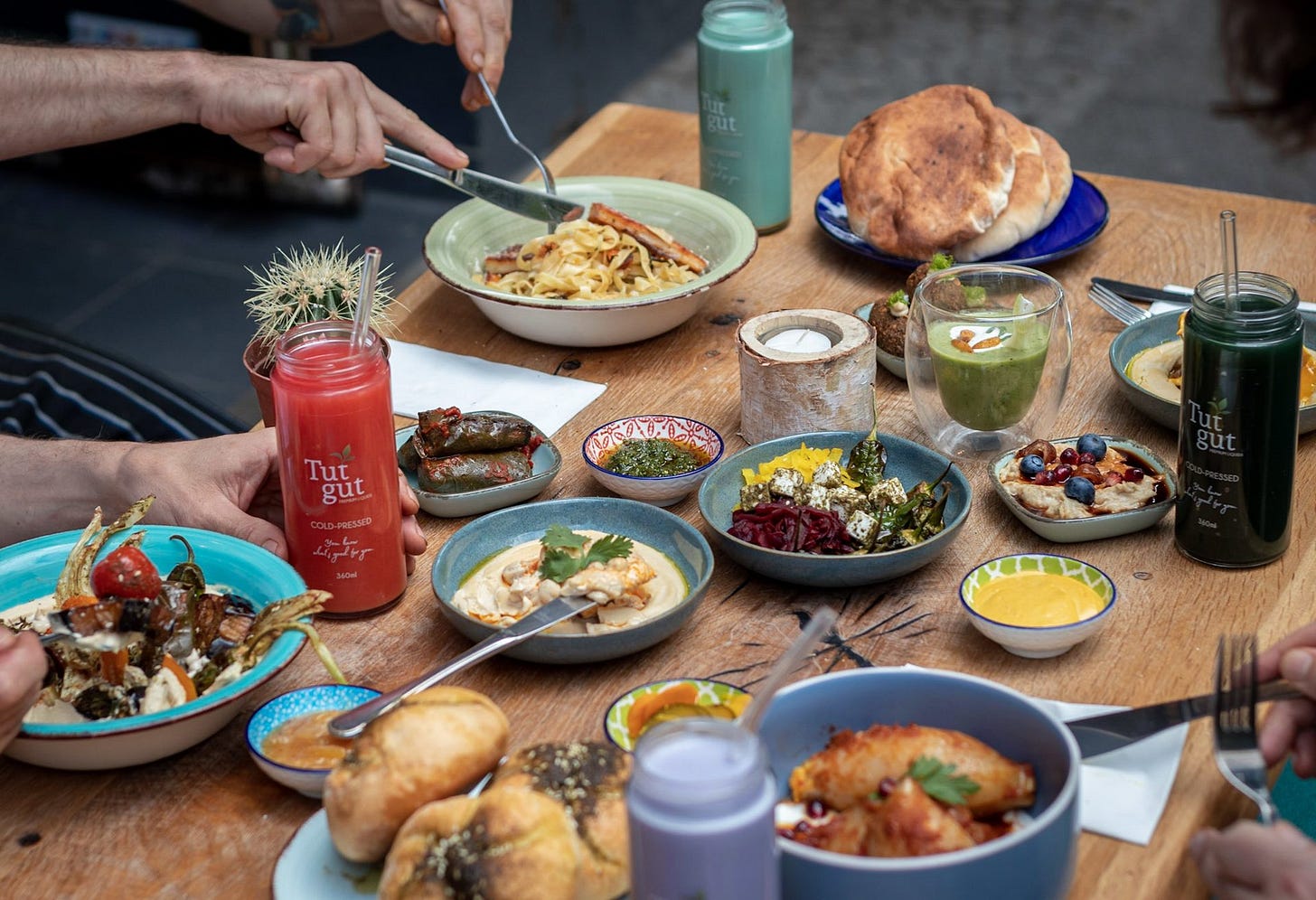
Kanaan (Schliemannstraße 15, 10437 Berlin, Germany). Okay gang, Kanaan is cool. It’s a vegetarian Middle Eastern share plates restaurant led by Israeli and Palestinian business partners who’ve designed their menu, space, and entire vibe around the significance and implausibility of their partnership. It’s a celebration of the hope they have for their people, without the saccharinity of other philosophy or purpose-driven restaurants. It also seems like a tasty and fun place to eat (get the shakshuka).
Prater Biergarten (Kastanienallee 7-9, 10435 Berlin, Germany). An enormously popular, and just plain enormous, outdoor beer garden, mainly for sampling Germany’s most-identifying beverage but also for their variations on sausages and potatoes, as well as flammkuchen (basically a hearty German pizza dressed kinda like a baked potato). Excellent drinks, excellent drinking food, what more could you want?
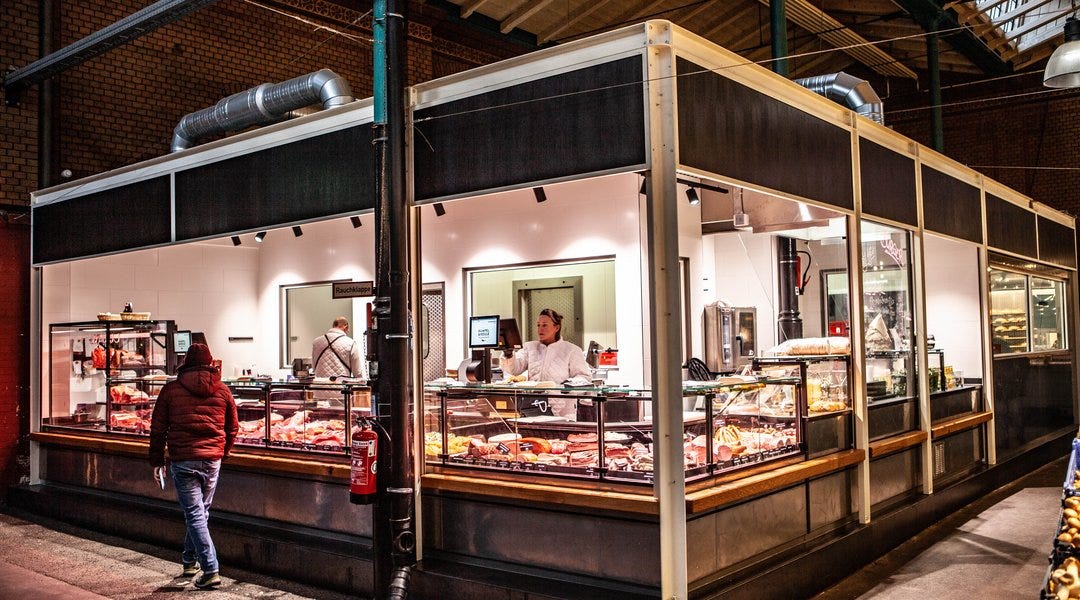
Markthalle Neun / Kumpel & Keule (Eisenbahnstraße 42/43, 10997 Berlin, Germany). When traveling, but also in general, I love a food hall for the quick exposure to so many local foods all in one place. The trade-off is that food halls can be a bit touristy, a bit chain-y, and occasionally a bit sterile. This is none of those. Markthalle Neun is a gorgeous, fun, and hyperlocal food hall that serves both farmstand products and restaurant food. There’s a broad, delicious-looking, decidedly international selection on offer here, but the one that stands out (and is recommended on so many Berlin food sites) is Kumpel & Keule, a butcher shop that apparently makes one of the best (if not the best) burgers in Berlin as well as simple, tasty sandwiches from many of their cured meats. From the looks of their website, you couldn’t go wrong eating anywhere here.
Der blaue Fuchs (Knaackstraße 43, 10435 Berlin, Germany). Apparently there’s a large Georgian community in Berlin, and that community’s food is popular. One popular place for this popular food is Der blaue Fuchs, a bright, cheery, airy restaurant with a wide spread of shareable dishes, from the hearty khachapuri to meaty khinkali dumplings to herbal salads, breads, and dips.
Chez Michel (Adalbertstraße 83, 10997 Berlin, Germany). As close to France as you may get in Berlin. Chez Michel is a Kreuzberg-neighborhood French bistro that is, by all appearances and descriptions, highly authentic. That means steak frites, escargot, entrecote, boeuf bourguignon, and profiteroles, as well as plenty of wine and beer. In a neighborhood that seems to be defined by hip, groovy, statement-making brunch cafes and sleek, intimate dinner restaurants, Chez Michel is uncomplicated, a casual, warm place to grab a good bite and a cool drink.
Risa Chicken (Lots of places). No need to trek to one, but if you’re out and about and hungry for a chicken-y lunch, Risa’s chicken will hit the spot. This is fast-rotisserie chicken and fries (and apparently sour pickles), from a beloved chain throughout Germany. Kind of like a faster-food, lower-scale German Nando’s.
Dinner

Night Kitchen (Heckmann Höfe, Oranienburger Str. 32, 10117 Berlin, Germany). 👍. An upbeat local Mediterranean spot with fresh, flavorful share plates (they bill themselves as “Israeli tapas”). Dishes both sound and look great in the positive online reviews, and their website makes it easy to book a table inside, in their outdoor garden, or at the bar (reservations are encouraged). They’ll build your party a personalized menu for the evening for a not-too-shabby 52 euro a head (that’s the “Dinner with Friends” option when booking) so you don’t have to think about anything except what to drink. The communal vibes are raucously impeccable. A restaurant that screams, “WELCOME to BERLIN!”
Lokal (Linienstraße 160, 10115 Berlin, Germany). Upscale, locally-sourced German cuisine in a cozy space. Lokal is one of the more highly-recommended restaurants in the city (by all the various food websites) for modern, updated German cuisine; but all those reviews also mention how approachable the restaurant is, both in its casual vibe and relative ease in securing a reservation compared to other high-profile dinner joints.
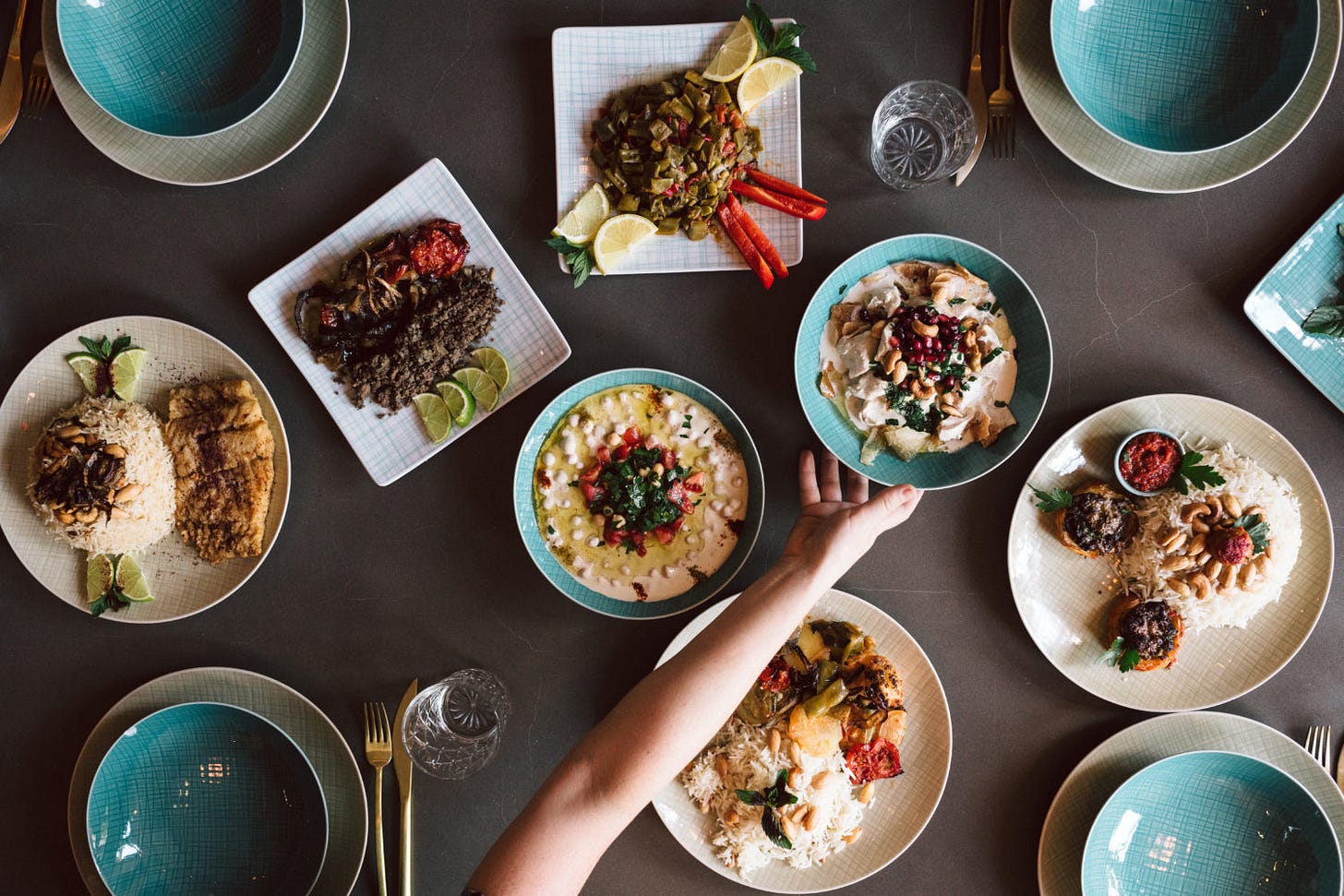
Malakeh (Potsdamer Str. 153, 10783 Berlin, Germany). As I’ve mentioned, Berlin is one of Europe’s most international and diverse cities, thanks to Germany’s friendlier immigration policy in contrast to many of its neighbors. That diversity naturally extends to its restaurant scene. Malakeh is a Syrian restaurant owned and operated by a Syrian immigrant who was once the TV face of cooking in Syria before war drove her to Germany. The restaurant looks comfortable, colorful, welcoming and fun, and the food is approachable, upscale, tasty Arab-Mediterranean.
Alt Berliner Wirtshaus Henne (Leuschnerdamm 25, 10999 Berlin, Germany). This is basically the German equivalent of a classic Southern fried chicken joint. Alt Berliner Wirsthaus Henne (a mouthful of a name even by German standards) specializes in broiled chicken; a juicy, crispy preparation of thigh served with a slice of bread, creamy potato salad, and coleslaw. You’ll enjoy this German-Fried Chicken plate (you will) in a dark, pubby, kitschy space clearly many years in the making. It is extremely likely that I would stop here if I was in Berlin.
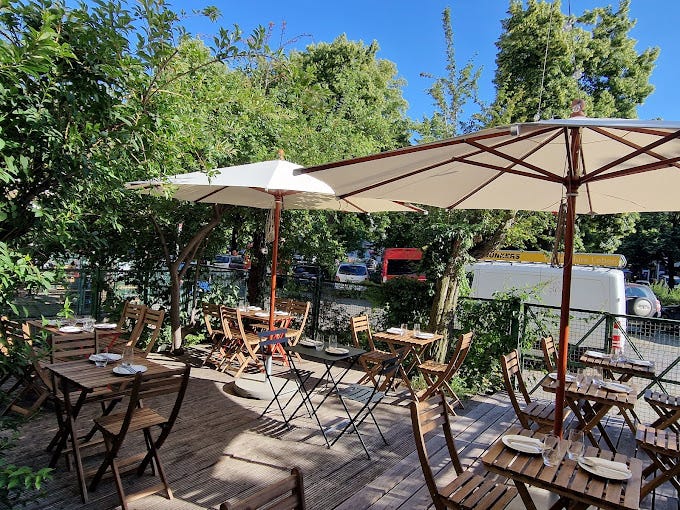
Lila (Paul-Lincke-Ufer 39-40, 10999 Berlin, Germany). 👍. Completely adorable seafood-focused patio-forward (it means what it means) restaurant. There’s nothing essentially Berlin or German about it (and it’s not particularly trying to be either of those things), but it seems like a great spot to have an easy, pretty, tasty night out; especially on their, again, completely adorable patio.
Grill Royal (Große Hamburger Str. 28, 10115 Berlin, Germany). I always say, if you’re going to go to a steakhouse, you might as well go to a steak-castle (rather, steak-schloss). Grill Royal is a big night out that appears worthy of your decadent steak night expectations in just about every way. Finely-prepared, rich food (with seafood options for those not in the mood for a T-Bone), crisp cocktails, an enormous wine selection, white tablecloths and practically unmatched river views (I’d request a window or outdoor table, weather & availability permitting). A place to go big before you go home.

Michelberger (Warschauer Str. 39-40, 10243 Berlin, Germany). 👍. Upscale, modern, seasonal & farm-fresh German cuisine at one of the city’s finer hotels. There’s no set menu, but you can probably bet on a selection of meat and vegetable plates riffing on German classics and making the most out of whatever’s in season at the hotel and restaurant’s namesake farm. All in all, a solid-to-great dinner option (with a gorgeous dining room).
Zur Letzten Instanz (Waisenstraße 14-16, 10179 Berlin, Germany). Perhaps the most classic German restaurant in Berlin, by virtue of (some version of) this establishment having been open since 1621(!). It is as old-German as you’ll find in the city — a vibe that comes with white tablecloths; dark, wood-paneled interiors; a breezy stone courtyard; and lots and lots of meat, potatoes, and beer on the menu. A real concentrated taste of Germany.
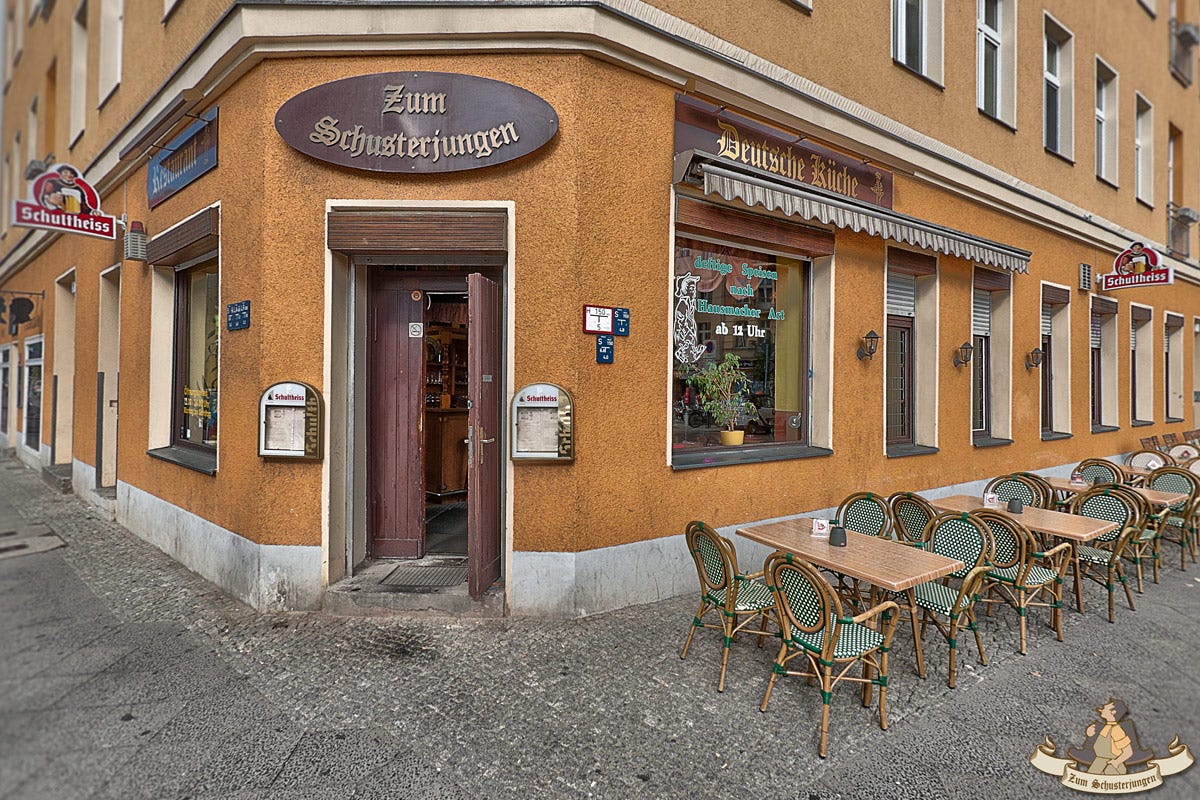
Zum Schusterjungen (Danziger Str. 9, 10435 Berlin, Germany). If you’re in the mood for a very casual, local, typical & traditional German dinner, this is probably your spot. Essentially a German pub, Zum Schusterjungen specializes in classic German plates like veal schnitzel and eisbein — a long-boiled, extremely tender pork shank/knuckle usually served over creamy mashed potatoes. In other words, a great place to relax. To be honest, it’s mostly on this list because I caught it on Bourdain’s last Berlin episode of Parts Unknown (which is one of his best TV episodes across all his shows), but the research seems to validate the plug.
Snacks & Cafes

Father Carpenter (Münzstraße 21, 10178 Berlin, Germany). Cafe Einstein Stammhaus has been recommended to me as a quite nice place to grab a slice of cake and a coffee and sit in a historic space; but unfortunately they’re closed for renovations. Fortunately there’s Father Carpenter, a different cafe also located in a historic building with its own beautiful stone courtyard, and plenty of cake, toasts, and coffee on offer.
Curry 61 (Oranienburger Str. 6, 10178 Berlin, Germany). A local, highly-rated, centrally-located spot for Berlin’s favorite late-night meal/snack. Looks fantastic. It’s a takeout joint, so eat it on the street or bring it back to your apartment if nearby. Best after at least several drinks.

YUNA (Oranienburger Str. 22, 10178 Berlin, Germany). This completely wonderful-looking cafe is smack in the middle of the city. Buttery pastries, tasty charcuterie boards, and housemade cakes galore are all available. Dine in their cozy space or snag one of the tables outside. Seems perfect to me for an afternoon break before later drinks & dinner adventures.
Zeit für Brot (Alte Schönhauser Str. 4, 10119 Berlin, Germany). A delicious-looking local chain bakery specializing in schneke, which is essentially a cinnamon roll, but with multiple types of flavors and fillings including apple, gooseberry, and dark chocolate. Seems great for a quick breakfast or snack pickup.
Windbeuterei Seshu (Oranienburger Str. 84, 10178 Berlin, Germany). We’re wrapping up with our most unpronounceable recommendation! Illegibility aside, this is a bakery specializing in cream puffs and lattes, and they look outstanding. Beard Papa’s got nothing on Windbeuterei Seshu, his time is over. Perfect for an impromptu late morning or mid-afternoon treat — or to pick up a box to keep at the apartment and nibble on throughout your stay.
Bonus
Illuseum Berlin. Just thought I’d throw this in here because I saw it while browsing. A museum of illusions! There’s another magic museum nearby, but that unfortunately looks pretty boring, just lots of your run-of-the-mill, ho-hum medieval dungeon & torture replicas. The Illuseum, however, seems genuinely fun, with a lot of tricky, interactive perspective exhibits designed specifically to make magic (and illusion!) enthusiasts happy.
Have your own personal favorite Berlin restaurant, or want to give a 👍 to your own experience with one of these recommendations? Am I very wrong about a recommendation or cultural, geographic, or culinary assumption? I want to know. I want to learn. Hit the comments.



